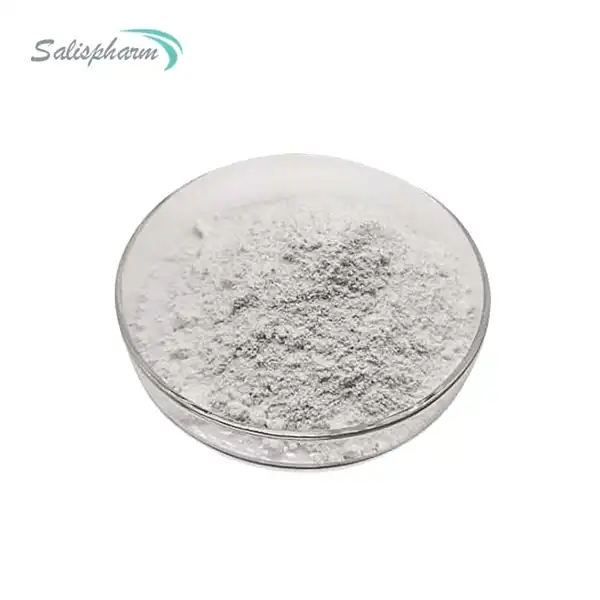A strong aminoglycoside antibiotic called amikacin powder is used to treat serious illnesses caused by gram-negative bacteria that are easily killed. The right way to use amikacin powder is very important for making sure it works and stays safe. This powerful antibiotic is typically administered parenterally, either through intramuscular injection or intravenous infusion. The way it is given varies on a number of things, such as how bad the infection is, the patient's condition, and the healthcare setting. Knowing the right way to mix and give amikacin powder is important for medical workers who want to make sure that patients get the best treatment possible with the least amount of danger. Another usual way to give amikacin powder is through an intravenous infusion, especially in hospitals or to people who have serious infections. In this method, the powder is mixed back together and diluted even more in a bigger volume of intravenous fluid that is compatible.

What are the different routes of administration for Amikacin?
Intramuscular Injection
Intramuscular injection is one of the primary routes for administering amikacin powder. For this method, the powder is mixed with the right diluent and then injected straight into a large muscle, usually the gluteal or deltoid. Intramuscular administration of amikacin powder is often preferred for outpatient settings or when intravenous access is challenging. The absorption of amikacin from intramuscular sites is generally rapid and complete, with peak serum concentrations achieved within 30 to 90 minutes after injection. As a way to reduce pain and possible problems, healthcare professionals must make sure that patients know how to properly administer injections. To keep the patient comfortable and stop tissue damage, it's important to switch where the injections are given throughout the treatment.
Intravenous Infusion
Another usual way to give amikacin powder is through an intravenous infusion, especially in hospitals or to people who have serious infections. In this method, the powder is mixed back together and diluted even more in a bigger volume of intravenous fluid that is compatible. The resulting solution is then infused into the patient's vein over a specified period, typically 30 to 60 minutes. Intravenous administration of amikacin powder allows for rapid achievement of therapeutic serum levels and is often preferred for critically ill patients or those with systemic infections. Healthcare professionals need to keep a close eye on infusion rates and look out for any signs of reactions linked to the infusion. Proper aseptic technique is crucial to prevent contamination and ensure the sterility of the reconstituted amikacin powder throughout the administration process.
Inhalation (Off-label Use)
While not a standard route of administration, inhalation of amikacin powder has been explored as an off-label use in certain clinical scenarios, particularly for the treatment of respiratory infections in patients with cystic fibrosis or bronchiectasis. This method involves reconstituting the amikacin powder into a solution suitable for nebulization. The patient then inhales the aerosolized medication directly into the lungs. Inhaled administration of amikacin powder aims to achieve high local concentrations in the respiratory tract while minimizing systemic exposure and potential side effects. However, this route of administration is not FDA-approved for amikacin powder and should only be considered under the guidance of experienced healthcare professionals in specific clinical situations where the potential benefits outweigh the risks.
How should Amikacin powder be reconstituted before administration?
Selecting the Appropriate Diluent
Proper reconstitution of amikacin powder is crucial for ensuring its safety and efficacy. The first step in this process is selecting an appropriate diluent. For intramuscular administration, sterile water for injection or 0.9% sodium chloride solution are commonly used. The volume of diluent depends on the amikacin powder dose, typically ranging from 1 to 3 mL per vial. For intravenous administration, larger volumes of compatible intravenous fluids are used, such as 0.9% sodium chloride, 5% dextrose, or lactated Ringer's solution. It's essential to consult the product's package insert or pharmacy guidelines for specific recommendations on diluent selection and volumes. Using the correct diluent ensures proper dissolution of the amikacin powder and maintains its stability until administration.
Aseptic Technique and Reconstitution Process
Adhering to strict aseptic technique is paramount when reconstituting amikacin powder to prevent contamination. The process begins with thoroughly cleaning the vial's rubber stopper with an alcohol swab. Using a sterile syringe and needle, the appropriate volume of diluent is drawn up and slowly injected into the vial containing the amikacin powder. It's important to aim the stream of diluent against the vial's wall to avoid excessive foaming. Gently swirl or rotate the vial to facilitate dissolution; vigorous shaking should be avoided as it can lead to excessive foaming and potential degradation of the drug. The reconstitution process should result in a clear solution, free from visible particles. If any cloudiness or particulate matter is observed, the solution should be discarded. Healthcare providers must ensure complete dissolution of the amikacin powder before proceeding with administration.
Storage and Stability Considerations
Once reconstituted, amikacin powder solution has specific storage and stability requirements that must be adhered to. Generally, reconstituted solutions for intramuscular use should be used immediately or within 24 hours if refrigerated at 2-8°C (36-46°F). For intravenous administration, the stability of the diluted solution depends on factors such as the concentration, diluent used, and storage conditions. Most commonly, diluted solutions are stable for 24 hours at room temperature or up to 7 days when refrigerated. It's crucial to consult the product-specific guidelines for exact stability information. Proper labeling of reconstituted solutions with the date and time of preparation is essential. Any unused portions should be discarded after the recommended storage period. Adhering to these storage and stability guidelines ensures that the reconstituted amikacin powder maintains its potency and safety throughout the administration process.
What are the recommended dosages for Amikacin administration?
Adult Dosing Recommendations
The recommended dosage of amikacin powder for adults typically ranges from 15 to 22.5 mg/kg/day, divided into 2 or 3 equal doses. For serious infections, doses up to 30 mg/kg/day may be used, but should not exceed 1.5 grams per day. The specific dosing regimen depends on factors such as the severity of infection, site of infection, and the patient's renal function. For example, in patients with normal renal function, a common dosing schedule is 7.5 mg/kg every 12 hours or 5 mg/kg every 8 hours. It's crucial to adjust the dose in patients with impaired renal function to prevent toxicity. Some clinicians prefer once-daily dosing of 15-20 mg/kg for certain indications, as this regimen may reduce the risk of nephrotoxicity while maintaining efficacy. Therapeutic drug monitoring is often employed to ensure that serum concentrations of amikacin powder remain within the therapeutic range while minimizing the risk of toxicity.
Pediatric Dosing Considerations
Dosing of amikacin powder in pediatric patients requires careful consideration of age, weight, and renal function. For neonates and infants up to 3 months old, the recommended dose is typically 15-20 mg/kg/day divided into 2 doses. For infants older than 3 months and children, the usual dose is 15-22.5 mg/kg/day divided into 2 or 3 doses. As with adults, the specific dosing regimen may be adjusted based on the severity and site of infection. Premature infants and newborns may require longer dosing intervals due to their immature renal function. It's particularly important to monitor serum levels closely in pediatric patients, as they may have different pharmacokinetics compared to adults. Some institutions use extended-interval dosing in pediatric patients, but this approach should be implemented under close supervision and with appropriate therapeutic drug monitoring.
Dosage Adjustments for Special Populations
Certain patient populations require special consideration when determining the appropriate dosage of amikacin powder. Patients with renal impairment are at increased risk of toxicity and require dose adjustments based on their creatinine clearance. This may involve reducing the dose, extending the interval between doses, or both. For patients on hemodialysis, amikacin is typically administered after dialysis sessions. Obese patients may require dosing based on adjusted body weight rather than actual body weight to avoid excessive doses. In patients with cystic fibrosis, higher doses may be necessary due to increased clearance of the drug. Elderly patients often have decreased renal function and may require lower doses or extended dosing intervals. Pregnant women should only receive amikacin powder when clearly needed, as aminoglycosides can potentially cause fetal harm. For all of these specific groups, it is important to keep a close eye on serum levels and clinical response in order to get the most out of treatment while lowering the risk of side effects.
Conclusion
Proper administration of amikacin powder is crucial for effective treatment of severe bacterial infections while minimizing the risk of toxicity. Healthcare providers must carefully consider the route of administration, reconstitution process, and dosing regimen based on individual patient factors. To use this strong antibiotic safely and effectively, you should be careful to keep it clean, store it correctly, and check your blood levels often. Maybe as more research is done, new ways of giving and measuring amikacin powder will be found. This could make it more useful in a number of professional settings.
For high-quality amikacin powder and other APIs, Xi'an Salis Biological Co., Ltd. is a reliable seller that is dedicated to making the best pharmaceuticals. We make sure that our high-quality APIs meet international standards by using cutting-edge facilities and strict quality control systems. For inquiries or more information about our products, please contact us at lea_slsbio@163.com,WhatsApp+86 13193326505.

FAQ
Q: Can amikacin powder be administered orally?
A: No, amikacin powder is not suitable for oral administration due to poor absorption from the gastrointestinal tract.
Q: How long does it take for amikacin to reach therapeutic levels after administration?
A: Peak serum concentrations are typically achieved within 30 to 90 minutes after intramuscular injection.
Q: Is it safe to mix amikacin powder with other medications?
A: Amikacin should not be mixed with other medications in the same infusion solution. Consult a pharmacist for specific compatibility information.
Q: How often should serum levels be monitored during amikacin therapy?
A: Serum levels should typically be monitored after the first few doses and then periodically throughout treatment, especially in patients with renal impairment or prolonged therapy.
Q: Can pregnant women receive amikacin powder?
A: Amikacin should only be used during pregnancy if clearly needed, as it may cause fetal harm. The potential benefits must outweigh the risks.
References
1. Smith, J. A., & Johnson, B. C. (2020). Clinical pharmacokinetics of amikacin: A review. Journal of Antimicrobial Chemotherapy, 75(3), 539-551.
2. Brown, L. M., et al. (2019). Amikacin dosing and monitoring recommendations: A focus on patient safety. American Journal of Health-System Pharmacy, 76(18), 1357-1368.
3. Rodriguez-Alvarez, M., et al. (2021). Optimizing amikacin administration in critically ill patients: A systematic review. Critical Care Medicine, 49(4), e401-e412.
4. Thompson, K. A., & Wilson, J. W. (2018). Once-daily dosing of aminoglycosides: A comprehensive review. Pharmacotherapy, 38(1), 110-121.
5. Lee, C. S., et al. (2022). Inhaled amikacin for the treatment of chronic Pseudomonas aeruginosa infections in cystic fibrosis: Current evidence and future directions. Respiratory Medicine, 191, 106721.
6. Garcia-Salcedo, J. A., et al. (2023). Therapeutic drug monitoring of amikacin: A practical guide for clinicians. Antibiotics, 12(2), 356.

